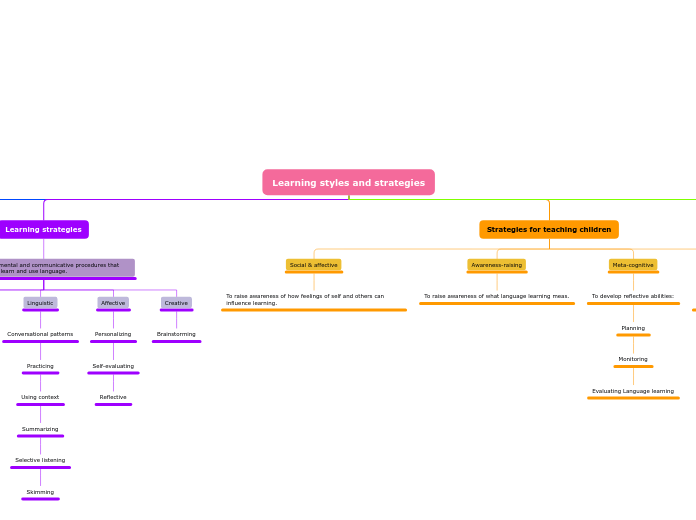Learning styles and strategies
Learning styles
It refers to the natural way of learning, the student's favorite or preferred way of learning.
Type 1: Cognitive
Field depedant
Field independant
Analytic
Global
Reflective
Impulsive
Type 2: Sensory
Perceptual
Visual
Auditory
Tactile
Kinesthetic
Environmental
Physical
Sociological
Type 3: Personality
Tolerance of ambiguity
Right and left hemisphere dominance
Learning strategies
It refers to the mental and communicative procedures that students use to learn and use language.
Cognitive
Classifying
Predicting
Inducting
Taking notes
Concept mapping
Inferencing
Discriminating
Diagramming
Interpersonal
Cooperating
Role-playing
Linguistic
Conversational patterns
Practicing
Using context
Summarizing
Selective listening
Skimming
Affective
Personalizing
Self-evaluating
Reflective
Creative
Brainstorming
Strategies for teaching children
Social & affective
To raise awareness of how feelings of self and others can influence learning.
Awareness-raising
To raise awareness of what language learning meas.
Meta-cognitive
To develop reflective abilities:
Planning
Monitoring
Evaluating Language learning
Direct or cognitive
To develop the ability to deal with linguistic information in an effective way.
Techniques for teaching strategies
For Younger Learners
Sensitize students towards learning
Stimulate what has been learned
Create a record of achievements
For Older Learners
Metacognitive
Reflective thinking
Self-evaluation
